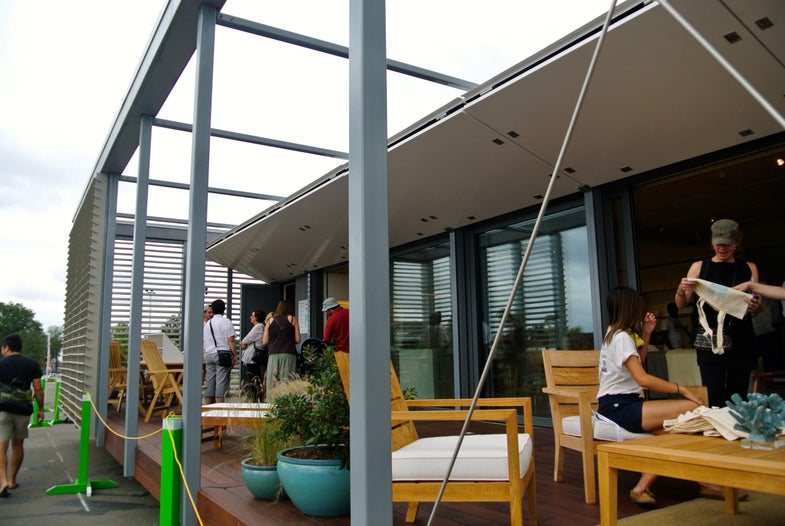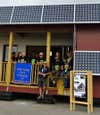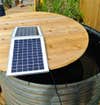How To Build A House That Saves The Earth And Your Wallet
These green homes could save you green

In the Solar Decathlon, a competition sponsored by the U.S. Department of Energy, college teams had to design and construct full-size houses that run entirely on solar power. And because the cost of each house couldn’t exceed $250,000, the competitors mostly used off-the-shelf technology.
“This is all available today,” says Solar Decathlon director Richard King. “[The teams] take everything that’s available and try to make something creative out of it.” That means the same innovative, sustainable solutions that went into the 14 Solar Decathlon houses—which were on display in Irvine, California this month—could also make their way to your shelf, your wall, or your roof.
Solar Technology

INhouse at the Solar Decathlon
If you’re going to go solar, you have options for which panels to use and how to position them. At INhouse, the California Polytechnic State University team used “bifacial” solar panels, which allow light to enter through both sides. The front side catches the Sun’s direct rays, while the back captures the ones reflected from the ground or roof. This type of panel costs about $500 per unit.
The STILE House team, a collaboration between West Virginia University and the Università di Roma, chose to put their solar panels on a north-south arch over the porch. The panels’ shadows provide cool shade for outdoor lounging, and their tilt means that the sun shines more effectively on different panels as it moves across the sky.

STILE House at the Solar Decathlon

DURA Home at Solar Decathlon
The DURA Home, meanwhile, presents a city-friendly solution to solar panels. If you live in the middle of a metropolis—and don’t own a penthouse—you probably don’t have a roof or a porch for solar panels. So the New York City College of Technology used more versatile, stackable panels with a sawtoothed, vertical design.
Team Orange County’s Casa Del Sol upped their panels’ efficiency by 10 percent—by taking a step out of the process. Solar panels normally send DC power, which another system must converts into AC power. But many home devices, like laptops and cell phones, can use that DC power. So Casa Del Sol used a Princeton Bidirectional Inverter to provide DC power and only convert it to AC when necessary.
Water Temperature
Most conventional houses use electricity or fuel to heat water, but a number of those at the Solar Decathlon harnessed the sun’s rays directly. After all, sunshine heats up the planet, so why not use it to heat your shower? The Missouri University of Science and Technology’s NEST Home runs water over its metal roof, which heats up during the day. At the competition, where the air temperature reached 106 degrees Fahrenheit, the system proved so efficient that the water almost boiled.

NEST Home’s Water-Heating System
The NexusHaus, a collaboration between the University of Texas at Austin and Germany’s Technische Universitaet Muenchen, collects water similarly, in a canopy that shades the porch.

NexusHaus at the Solar Decathlon
The DURA Home team made use of a prefab system called SunDrum, which uses the excess heat that solar panels themselves create to warm up water and generate more electricity.
But Casa Del Sol had perhaps the most innovative solution: They captured heat with evacuated glass tubes, which cost about $10 each. Then they used this warmth to heat water, which ran through the pipes to make showers pleasant.
Air temperature
Casa Del Sol’s hot water can also flow into the house’s ceiling. There, flexible plastic tubes called PEX radiate the heat from the hot water as it runs through them. The same system can also cool the house by using chilled water. And the tubes only cost $30 to $50 for every 100 feet.
At Indigo Pine, the cooling comes from below rather than above. The Clemson University team gave their cement foundation a checkerboard middle, with open spaces. This allows the ground to passively cool or heat the air.

Indigo Pine at the Solar Decathlon
But the team from the University of California at Davis had the coolest air conditioning. The sloped roof of their Aggie Sol house funneled rainwater into a container. At night, when the air was cooler, their system fed water back up to the roof and shot it out using sprinklers. Air exposure cooled the water, and when it fell back onto the roof, it returned to the rainwater container before flowing under the floorboards to chill the house.

Aggie Sol at the Solar Decathlon
Materials

Solar Decathlon – NEST Home Materials
Most of the houses used recycled or reclaimed materials. Like a bird’s house, the NEST Home was constructed entirely out of discarded bits and pieces. The team used wooden pallets to make the outside and shipping containers to form the interior structure.
Both the INHouse and Team Alfred’s ALF were held up by structurally insulated panels, which combined the strength of a wall and the temperature-moderation of insulation. Each square foot of paneling cost four to six dollars. The STILE House opted for a cheaper insulation (about two dollars per square foot) made of recycled denim—because those flared-leg jeans have to go somewhere.
The creators of Indigo Pine came up with a whole construction system, called SimPLY. It sent instructions to a computer numerical control (CNC) machine, which cut wood into pieces. Then this pre-cut lumber could be shipped to the construction site and snapped together, like LEGOs or Ikea furniture, sans power tools.

Indigo Pine’s SimPLY System at the Solar Decathlon
Green Space
Science says we’re happier when we see green space. And our checking accounts are happier if we’re not buying packages of organic cherry tomatoes every two days. The Decathletes often combined the desire for flora with the desire to eat. Students from University at Buffalo, The State University of New York centered their GRoW Home on the idea that even residents of northern New York should have vegetation year-round. Their home includes a 320-square-foot greenhouse. With a little (okay, a lot) of fiddling, a porch on an existing home could be transformed into a perennially plant-friendly environment.

GRoW Home at the Solar Decathlon

NEST Home’s Wall of Plants
Hydroponic gardens also abounded. Downsloping pipes at NEST Home used gravity to water plants. The Reflect Home, created by the California State University, Sacramento, housed a vertical “living wall”—you can make your own from felt.
At ALF, the focus was on the lawn. Americans love their lawns, but the grass is always greener when you water it—a lot. Instead of wasting water, the team installed Pearl’s Premium Ultra-Low Maintenance lawn, which requires less water than succulents and captures four times as much carbon as a typical yard. A five-pound bag of Pearl’s will set you back $36.

ALF’s Lawn at the Solar Decathlon
Weather-proofing
The airtight, waterproof SURE House, which won the gold medal at the event, uses an amazing 90 percent less power than a traditional house. Its deployable storm shutters, which act as a shade when up and also can collect solar energy, require just 20 pounds of force to pull down. The house can be totally stormproof in 45 minutes, which was important to the team, who were inspired by Hurricane Sandy.

SURE House at the Solar Decathlon
The EASI House is a joint effort of Western New England University, Universidad Tecnológica de Panamá, and Universidad Tecnológica Centroamericana. It can withstand powerful, hurricane-force wind and earthquakes because of the anchors holding it to the ground.
The Crowder College and Drury University team also designed the Shelter-R3 house with a natural disaster in mind. In their case, it was the 2011 Joplin tornado. They built a modular home so it can be shipped and assembled fast. This enables it to provide power to other houses in a disaster and act as a base for rescue operations.

Shelter R3 at the Solar Decathlon
Each Solar Decathlon team had a different target audience in mind, ranging from the inhabitants of Tornado Alley to urban families to farm workers. But all of them hope that making their technology and innovation public will help people everywhere live more sustainably. If you can afford bifacial solar panels and bidirectional inverters, great! If not, a homemade living wall is a great place to start.
